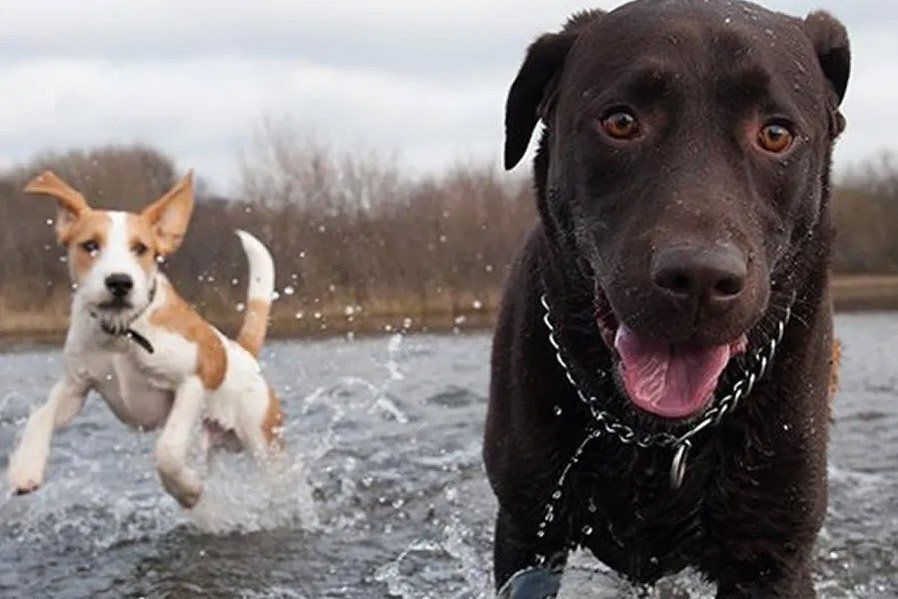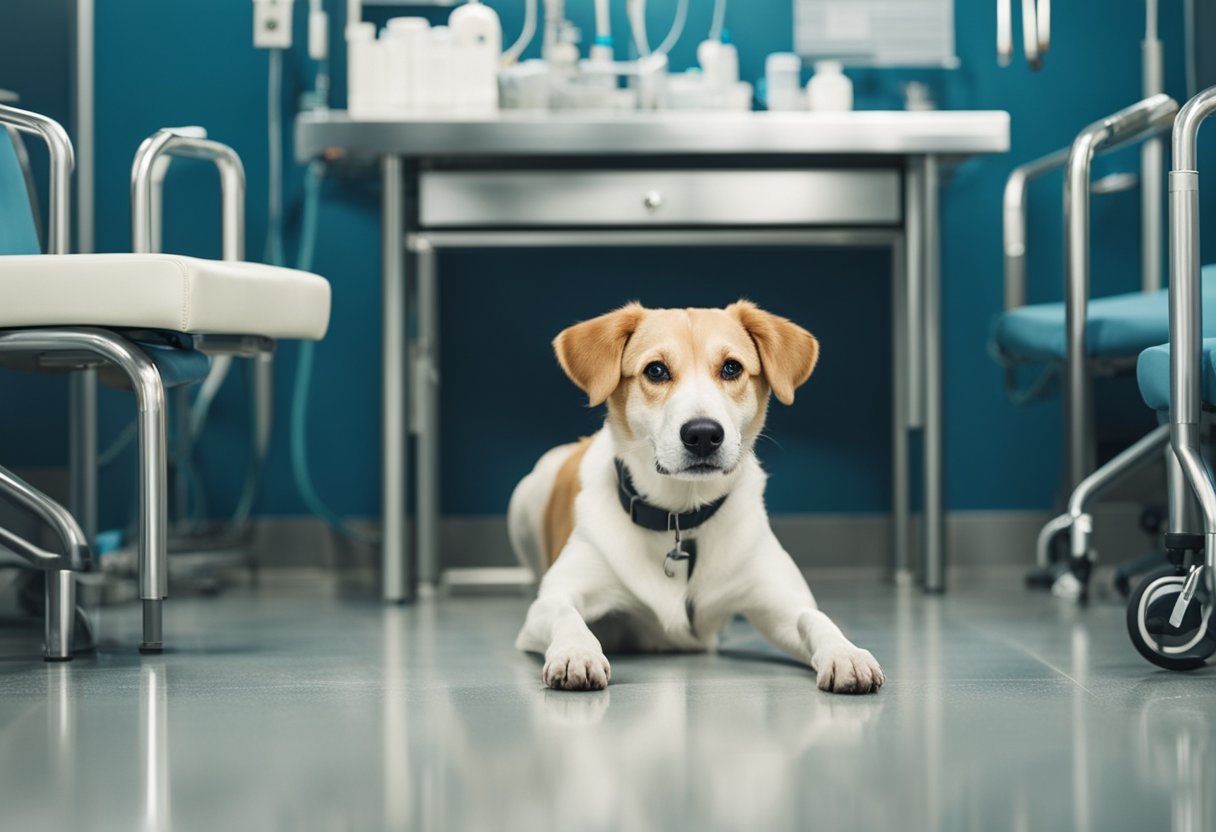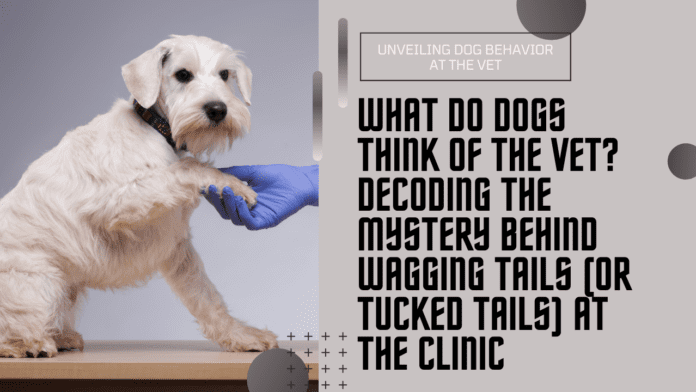Last Updated on April 11, 2024 by Dog Lover
What Do Dogs Think of the Vet? Decoding the Mystery Behind Wagging Tails (or Tucked Tails) at the Clinic
Have you ever wondered what goes through your furry friend’s mind during a trip to the vet?
Their apprehension is often palpable – those tucked tails and whimpers speak volumes. But what exactly are they thinking? Unlike Hollywood portrayals of happy pups receiving belly rubs at the clinic, the reality for many dogs is far less glamorous.
This article delves into the fascinating world of canine cognition, exploring how dogs perceive the vet experience.
We’ll uncover the reasons behind their common anxieties, unpack the power of positive reinforcement, and offer tips to make vet visits less stressful for both you and your beloved pooch.

Understanding the Canine Perspective
Dogs, as much as we love them, don’t possess the same level of cognitive ability as humans.
They live in a world dominated by scents, sounds, and immediate experiences. Unfortunately, the vet’s office is a sensory overload for most dogs.
The unfamiliar sights, the pungent disinfectants, the cacophony of barks and meows – it’s all a recipe for canine unease.
:strip_icc()/scared-of-vet-174675383-resized-56a26ace3df78cf77275634e.jpg)
Unpacking the Fear: Why Vets Can Be Scary for Dogs
Imagine being prodded and poked by strangers in a cold, sterile environment filled with unsettling smells.
That’s what a trip to the vet can feel like for many dogs. Here’s a breakdown of the common fear factors:
- Unfamiliar Surroundings: The vet clinic is a stark contrast to the comfort and familiarity of your dog’s home environment.
- Negative Experiences: Past vet visits involving vaccinations, examinations, or unpleasant procedures can leave a lasting negative impression.
- Restraint: Being held down by strangers can be highly stressful for dogs who crave freedom and control.
- The White Coats: Studies suggest dogs may associate white coats with negative experiences, similar to how children might fear doctors in lab coats.

Beyond Fear: Positive Associations with the Vet
The good news is that we can help our furry companions develop a more positive association with the vet.
Here are some strategies:
- Schedule “Well Visits”: Don’t wait until your dog is sick to visit the vet. Schedule regular checkups to create positive experiences that involve treats, praise, and gentle handling.
- Turn the Car Ride into a Treat Time: Associate car rides with positive experiences by taking your dog to fun places besides the vet. Offer treats and praise during the journey.
- Befriend the Staff: Get to know the vet technicians and veterinarians beforehand. Allow your dog to interact with them in a relaxed setting, like during a scheduled “happy visit.”
- Positive Reinforcement is Key: Reward your dog with praise, treats, and petting throughout the vet visit for calm behavior. This reinforces a positive association with the experience.
Creating a Calm and Confident Canine Companion
By understanding your dog’s perspective and implementing these strategies, you can transform vet visits from stressful ordeals to tolerable (or even enjoyable!) experiences.
Remember, a calm and confident owner helps create a calm and confident canine.

Addressing Specific Dog Anxieties
Does your dog exhibit extreme anxiety during vet visits? Fear not, we’ve got you covered!
Here are some tactics to address specific anxieties:
- Severe Fear: For dogs with severe anxieties, talk to your veterinarian about anti-anxiety medication or calming techniques like desensitization therapy.
- Noise Phobias: If your dog is particularly sensitive to noise, consider scheduling appointments during quieter times or requesting an exam room away from the main hustle and bustle.
- Separation Anxiety: Some dogs struggle with being separated from their owners. If this is the case, discuss strategies with your vet, such as allowing you to stay present during the examination.
Beyond the Exam Room: Tips for a Smooth Vet Visit
A little preparation goes a long way.
Here are some additional tips to ensure a smooth vet visit for both you and your canine companion:
- Exercise Your Dog Beforehand: A tired dog is a less anxious dog. Take your dog for a walk or playtime before the appointment to burn off excess energy.
- Pack Familiar Comforts: Bring along your dog’s favorite blanket, toy, or a worn t-shirt with your scent on it to provide comfort and a sense of security.
- Maintain a Positive Demeanor: Dogs are adept at picking up on our emotions. Stay calm and positive throughout the visit. Your confidence will help to reassure your dog.
Conclusion: Building a Positive Partnership with Your Vet
Remember, your veterinarian is your partner in keeping your dog happy and healthy. By working together and implementing these tips, you can create a positive and stress-free environment for your dog during vet visits.
This not only makes the experience less traumatic for your furry friend, but also allows the veterinarian to conduct a more thorough examination, leading to better overall care for your beloved pooch.
FAQs
Here are some frequently asked questions about dogs and vet visits:
Should I stay with my dog during the vet exam?
This depends on your dog’s temperament and level of anxiety. For some dogs, having their owner present can be a source of comfort. However, for others, it may create additional stress if the owner becomes anxious themselves. Discuss this with your veterinarian beforehand to determine the best approach for your individual situation.
What are some signs that my dog is scared at the vet?
Common signs of anxiety in dogs at the vet include whining, panting, pacing, excessive licking, trembling, tucked tails, and flattened ears.
How can I make getting in the carrier less stressful for my dog?
- Leave the carrier out in the open at home: Allow your dog to become familiar with the carrier by leaving it out with the door open and placing some of their favorite toys or treats inside.
- Make carrier travel positive: Practice short car rides with your dog in the carrier, rewarding them with treats and praise for calm behavior.
- Use a comfortable carrier: Ensure the carrier is the right size for your dog and provides adequate ventilation. Consider lining it with a soft blanket or bed.
What are some alternatives to traditional carriers for anxious dogs?
For some dogs, a backpack-style carrier or a soft-sided carrier may be less intimidating than a hard-shell crate.
Is it okay to bribe my dog with treats during the vet visit?
Absolutely! Using treats as positive reinforcement during the vet visit is a great way to encourage calm behavior and create positive associations.
By following these tips and fostering a positive relationship with your veterinarian, you can ensure that your dog’s vet visits are less stressful and more beneficial for everyone involved.
Verified Sources:
- American Veterinary Medical Association: https://www.avma.org/
- The Association for Pet Dog Trainers: https://apdt.com/
- Canine Journal: https://www.caninejournal.com/


















